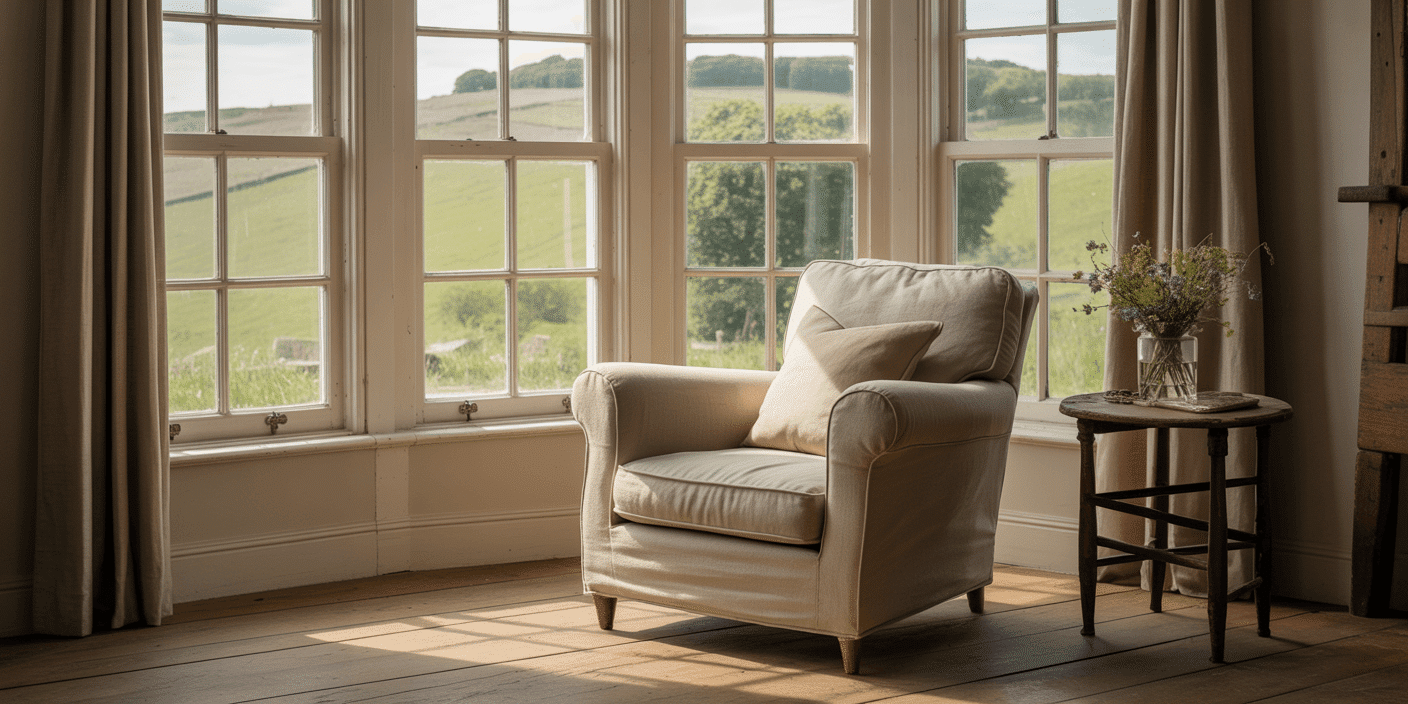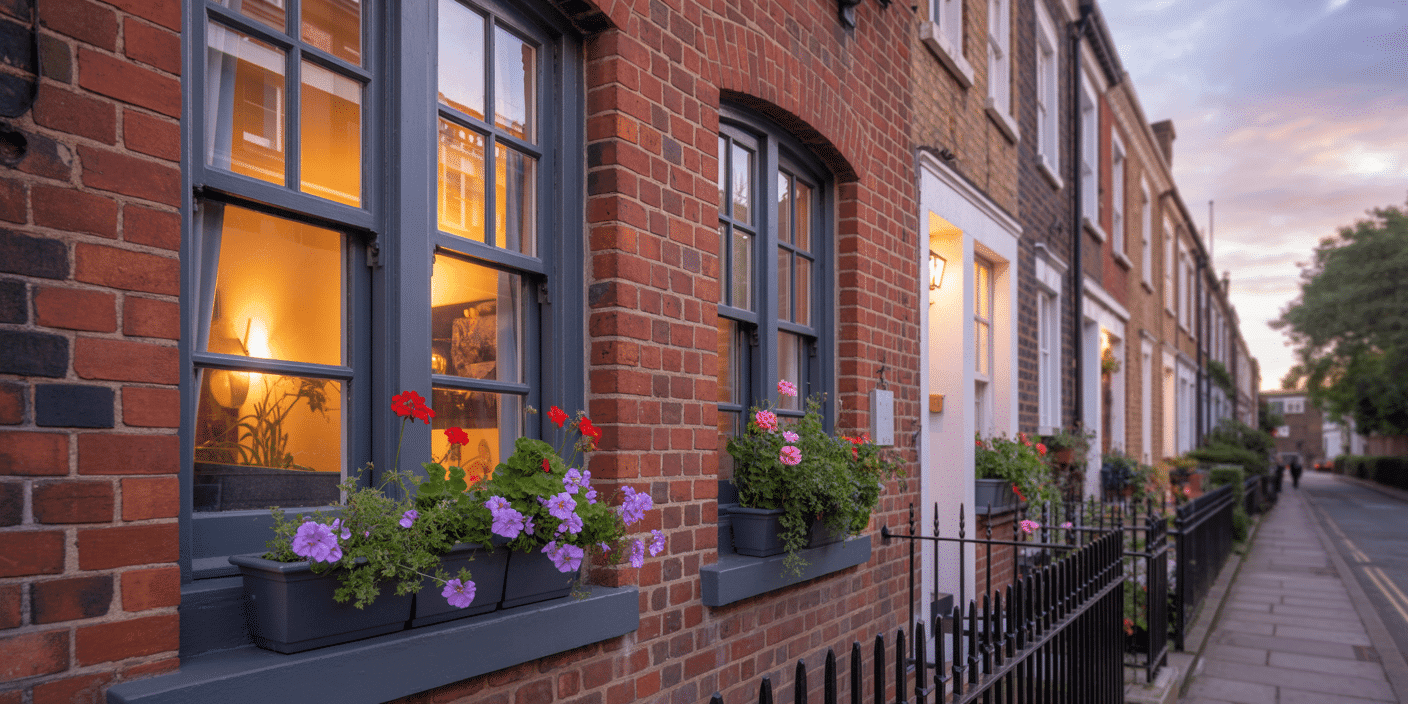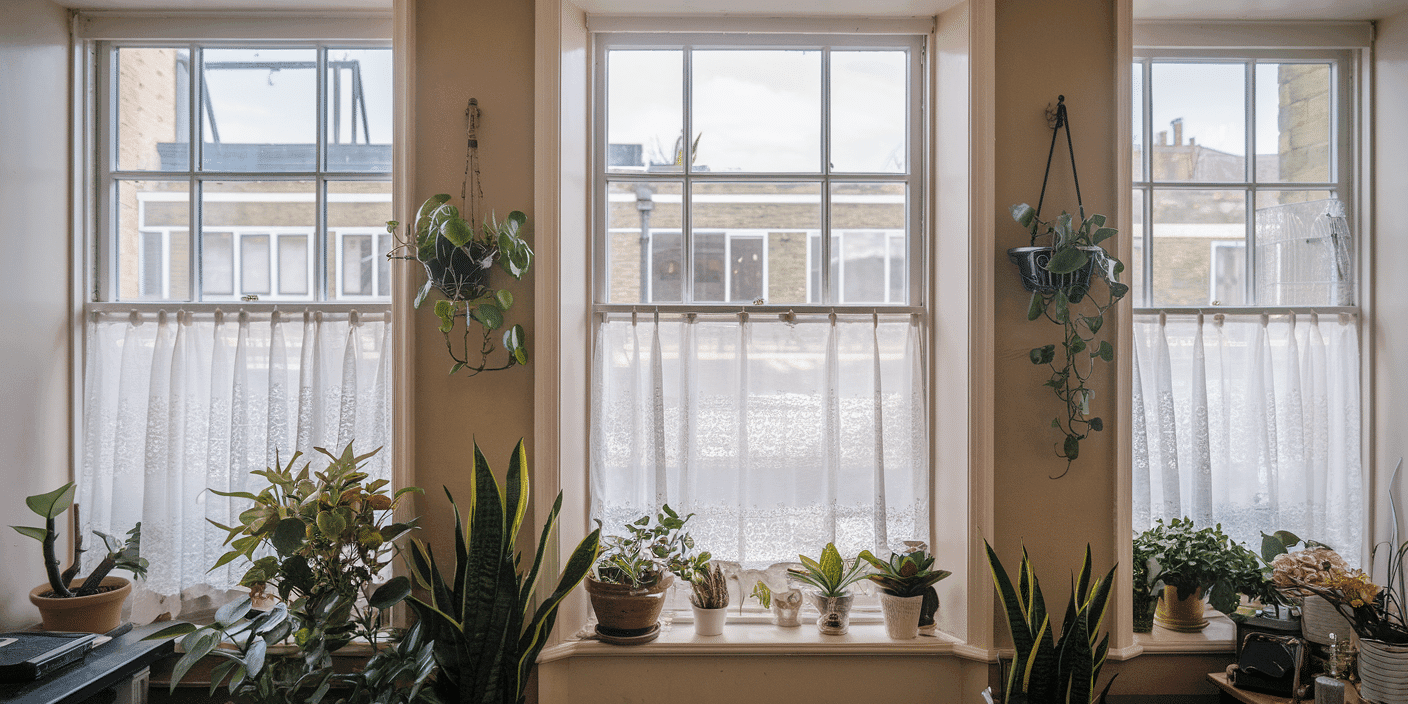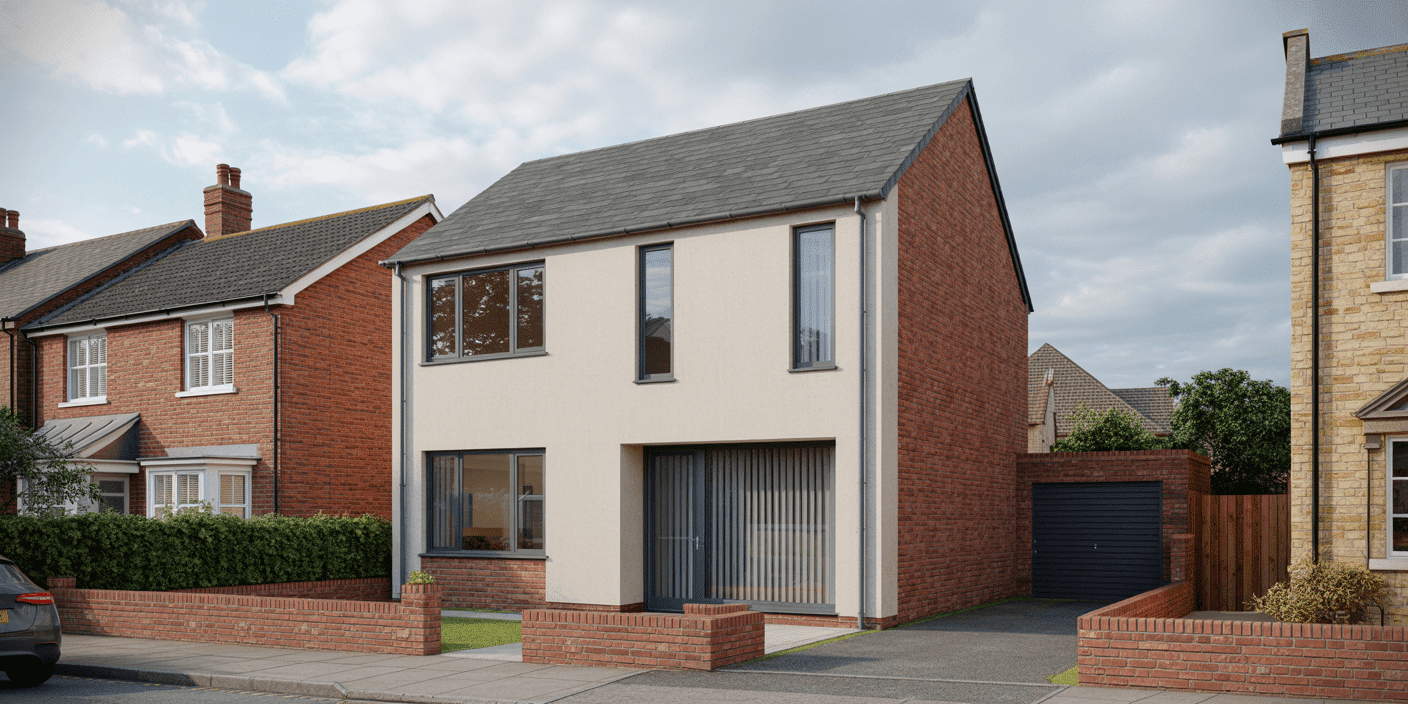THE LIE YOU’VE BEEN SOLD
“You must choose: aesthetic or performance.”
For years, homeowners of period and heritage properties have been presented with a binary that should never have existed. A false trade-off between architectural integrity and modern thermal performance.
Do you want beauty or comfort? Elegance or efficiency? Original windows or lower energy bills?
Most chose character—often with hesitation. They accepted draughts, swelling frames, and cold floors rather than disfigure their home with bulky uPVC or ill-proportioned replicas. The cost: rising energy bills, reduced comfort, and growing difficulty meeting evolving regulatory standards.
Planners reinforced the impasse, insisting visible double glazing would be refused. Installers defaulted to compliance over craft. Architects specified defensively, assuming compromise was inevitable.
And so the myth endured: if your home had history, its windows could not offer performance.
That position is no longer defensible.
Today, there are window systems that deliver verified thermal efficiency, meet current building regulations, and do so with authenticity indistinguishable from the original architecture.
These are not compromises. They are precise, engineered solutions—where craft meets compliance, and heritage need not come at the expense of performance.
The standard has shifted.
And the era of either/or is over.
WHAT’S REALLY AT STAKE
“Every draught is a decision you didn’t make.”
We tend to overlook windows until they fail us. A cold patch near the sofa. A whisper of wind on a still night. A room that never quite warms up in winter, and overheats by mid-July.
But these small discomforts are symptoms of a much larger cost—measured not just in money, but in comfort, energy, and future value.
Up to 25% of a home’s heat is lost through its windows.
Over time, that loss becomes a ledger of regret:
- Higher heating bills in a world of rising energy costs
- Lower EPC ratings that affect resale and mortgage value
- Constant strain on HVAC systems, insulation, and occupants
- A growing gap between how a home looks and how it lives
And then there’s regulation.
Part L of the Building Regulations isn’t optional.
Nor are the minimum energy performance standards soon expected for privately let and owned homes. The law is moving. And so are property valuations.
Most homeowners don’t wait until a boiler bursts to think about insulation.
But when it comes to their windows—the most visibly inefficient part of a home—many continue to delay. Because they think replacing them means giving something up.
What’s really at stake, then, isn’t just warmth. It’s the ability to own a home that’s beautiful, liveable, and future-proof—without compromise.
And that begins by asking the right question:
Not what must I give up?
But rather: what’s the real cost of keeping things as they are?
WHERE OTHERS COMPROMISE, WE ENGINEER

“Performance doesn’t have to be ugly.”
Most window suppliers still believe that improving thermal performance means bulking up. Thicker frames. Wider glazing gaps. Clunky sightlines. More plastic. Less charm.
They approach energy efficiency with the blunt force of modern materials—never mind that the home in question predates the lightbulb.
That’s where craftsmanship ends. And engineering begins.
Because in today’s best systems, performance is no longer at odds with proportion. Technology has caught up with tradition.
And it’s changing everything.
Vacuum Insulated Glazing (VIG)
A marvel of modern glazing—VIG uses a microscopic vacuum between two panes of glass to deliver U-values below 0.7 W/m²K in a form thinner than many single-glazed units. That means you get near triple-glazing thermal performance… in a visually indistinguishable profile.
Slimline Double Glazing Units (DGU)
Perfect for listed buildings and conservation areas, Slimline DGU delivers discreet thermal protection while preserving your original sash bar detail. In the right hands, it’s invisible. In the wrong hands, it’s banned.
Thermally Broken Frames
Especially in aluminium and composite systems, thermal breaks reduce heat transfer across the frame, preventing condensation, edge loss, and frame chill. Today, they’re precision-machined to follow classic heritage proportions.
Low-Emissivity Coatings
Modern low-E coatings and inert gas fills (like argon or krypton) enhance insulation while remaining completely transparent. No tints. No green hues. Just clear, quiet efficiency.
The myth that “old homes can’t have modern performance” is not just outdated—it’s lazy.
The truth is: a window can be built for beauty and engineered for today’s standards.
You just need the right people building it.
THE RULES HAVE CHANGED
“Conservation doesn’t mean concession.”
For years, building regulations and planning officers seemed to speak different languages.
On one hand, Part L, demands ever-lower U-values and improved thermal performance in the name of national energy targets.
On the other hand, conservation officers guard heritage assets against anything that even hints at modernity.
Caught in the middle were homeowners—told by one authority to upgrade, and by another that they couldn’t.
That friction led many to give up. To patch and repaint. To tolerate discomfort for the sake of a façade.
But that landscape has changed. Quietly. Profoundly.
Part L: Thermal Performance
Updated in 2022, Part L requires window replacements to meet specific U-values. But exemptions exist for listed buildings and conservation areas—as long as the upgrades preserve the building’s character. That doesn’t mean doing nothing. It means doing it right.
Part Q: Security Standards
New homes and converted dwellings must now meet PAS 24 standards for resistance to forced entry. That’s entirely achievable with bespoke timber windows—without sacrificing elegance.
Part K: Safety from Falling
Especially relevant for upper-floor sashes and casements, this regulation governs window height and opening limits. A specialist installer can design systems that comply with and meet conservation aesthetics.
Listed Building Consent & Conservation Approval
Planners are no longer hostile to performance—as long as the design respects the original sightlines, materials, and detailing. Many local authorities now approve slimline double glazing, vacuum units, and thermally broken sash frames on a case-by-case basis.
The message is clear:
You are allowed to improve your home.
What matters is how you do it.
No shortcuts. No uPVC disguises. No soulless hacks.
Just intelligently specified, beautifully executed window systems that satisfy everyone—the planner, the energy assessor, and most importantly, you.
SILENT LUXURY: THE NEW STANDARD
“The finest things are often the quietest.”
Luxury doesn’t shout. It doesn’t demand attention with flashing labels or exaggerated claims. It operates quietly—in the details, the decisions, the difference between acceptable and exceptional.
In the world of windows, luxury used to mean handcrafted joinery, slender glazing bars, and polished brass fittings. And it still does.
But today, luxury also means comfort you don’t have to think about.
No draughts. No rattle. No winter condensation streaking down the inside of your glass. Just quiet, radiant warmth—and timeless beauty, exactly as you imagined it.
We call it invisible performance.
Your guests won’t notice it. That’s the point.
They’ll admire the Georgian proportions, the heritage horn detail, and the subtle putty lines.
They won’t realise the sash they’re looking through achieves a U-value of 0.8. Or that the frame is thermally broken and triple brush-sealed. Or that it reduced ambient street noise by 60%.
That’s not by accident. It’s the result of a design that refuses to compromise.
Not for speed. Not for cost. Not for fashion.
Because for the kind of client who lives in a conservation area, or restores a period townhouse, or commissions bespoke work, luxury is precision.
You didn’t choose your home because it was easy.
You chose it because it has soul.
And the comfort you expect from it shouldn’t come at the cost of its character.
HOW CRAFT MAKES THIS POSSIBLE

“Because heritage is more than just an aesthetic.”
A high-performance window that looks like it’s been there for 150 years doesn’t happen by luck. It happens through craft—measured in microns, executed in millimetres, and tested against the toughest critics: time, weather, and planning.
This is where mass manufacturing can’t go.
Where uPVC folds.
Where the difference between passable and perfect lies in the shadow line of a glazing bar, or the sweep of a lamb’s tongue moulding.
At Sash Windows London, we don’t start with stock profiles and work backwards.
We begin with your building, your planning constraints, and your performance targets. Then we build a solution from the grain up—handcrafted in our joinery, not fabricated offshore.
✅ Sightline Matching
Every visible detail is engineered to match the original window—sash depth, horn detailing, putty profiles, and frame-to-glass ratios. This is what passes for planning. And this is what keeps the soul of the building alive.
✅ Performance Spec, Built In
Vacuum glazing? Slimline double units? Thermally broken sills and frames? These aren’t optional upgrades—they’re designed in from the first draughting. We specify to exceed Part L, not just meet it.
✅ Compliance Without Guesswork
Whether it’s listed building consent, Part Q security standards, or Part K safety rules, our systems are built with one goal: approval the first time. No costly redrafts. No planner pushback. Just evidence-led design that works.
✅ Installation With Intelligence
We don’t outsource. Our installation teams are trained in both conservation sensitivity and airtightness protocols. That means your windows arrive properly sealed, perfectly fitted, and precisely what you were promised.
Because when you live in a property with history, there’s no room for shortcuts.
And when you invest in something that touches your life every day—light, warmth, quiet, beauty—you deserve to know it’s been built without compromise.
Craft is not a luxury.
It’s the only way this works.
THE HOMES THAT PROVE THE POINT
“If you’ve seen it in Mayfair, Chelsea or Hampstead… chances are, you’ve already seen our work.”
We could talk all day about craftsmanship, performance and compliance.
But nothing proves the point quite like the homes themselves.
Across London and the South East, our windows quietly live inside some of the most exacting addresses in the country—often where planning constraints are fierce, conservation demands are rigid, and homeowners simply won’t settle for second-best.
Not showroom pieces. Real homes. Real histories. Real transformation.
Case 01: Grade II Listed Townhouse – Kensington
A 5-storey Georgian property, constrained by heritage sightline regulations and a cold north-facing façade. The brief: retain original timber charm, but meet EPC requirements for rental.
Our solution: VIG glazing with full conservation sightline replication, plus thermally broken hardwood frames. U-values halved. EPC rating lifted. Planning approved at first submission.
Case 02: Edwardian Semi – Highgate Conservation Area
Owners wanted to future-proof without attracting attention. We replaced all sash windows with slimline double-glazed timber units, fully matched to original profiles. No planning objections. Acoustic performance exceeded expectations—60% reduction in street noise, confirmed by third-party testing.
Case 03: Developer Retrofit – Chelsea Mews Conversion
Facing pressure to meet Part L and Part Q in a conservation context, the developer feared delays and costly redesigns. Our team specified PAS 24-certified heritage sash units, integrated security features, and prepared documentation for a smooth building control sign-off. The project stayed on track, and planners commented on the “exemplary” glazing detail.
These aren’t exceptions.
They’re what happens when design, regulation and craftsmanship are integrated from day one.
We don’t believe in “just good enough.”
We believe a window should satisfy the eye, the planner, and the performance spec sheet—in one unified system.
Because once you’ve seen what’s possible, anything else feels like a compromise.
COMPLIANCE WITHOUT COMPROMISE
“We don’t believe you have to choose. And now, you don’t.”
You shouldn’t have to sacrifice thermal comfort to satisfy a planner.
You shouldn’t have to lose your home’s heritage to meet Part L.
And you definitely shouldn’t settle for soulless solutions in the name of progress.
You deserve a window system that honours your home’s past and secures its future.
We’ve spent over a decade crafting precisely that—heritage glazing systems that exceed modern performance targets, pass conservation scrutiny, and leave every detail exactly as it should be: correct, refined, beautiful.
This isn’t a compromise.
It’s compliance, without concession.
It’s comfort, without clutter.
It’s elegance, engineered to endure.
If you’re renovating, restoring, or specifying windows for a period or high-value home, the time to act is now. Building regulations are tightening. Energy costs are rising. And the solutions that used to be impossible are now available, approved, and exquisite.
✅ Your next steps:
- Download our “Compliance Without Compromise” specification guide
For architects, homeowners, and developers working within listed and conservation areas. - Book a thermal + planning consultation
We’ll assess your current windows and advise on what’s possible—visually, structurally, and legally. - Request a case study pack
See the homes we’ve transformed and how we worked with planners to get every detail signed off.







